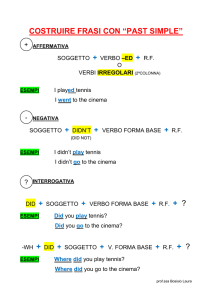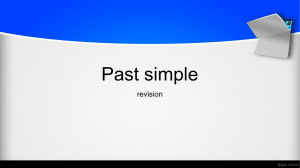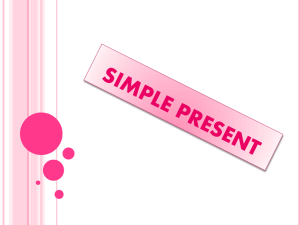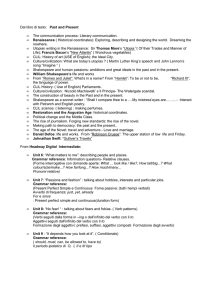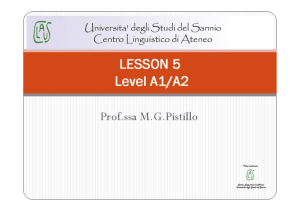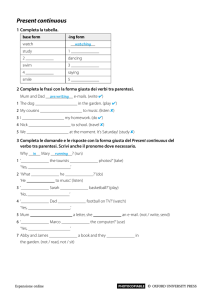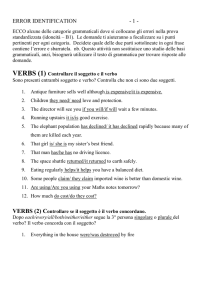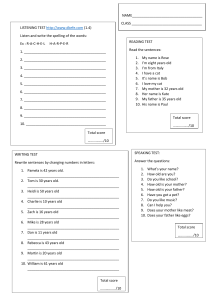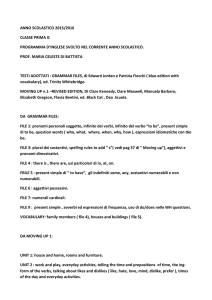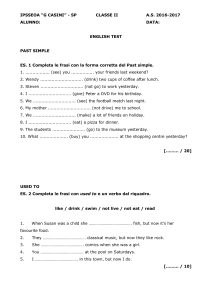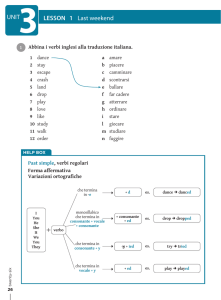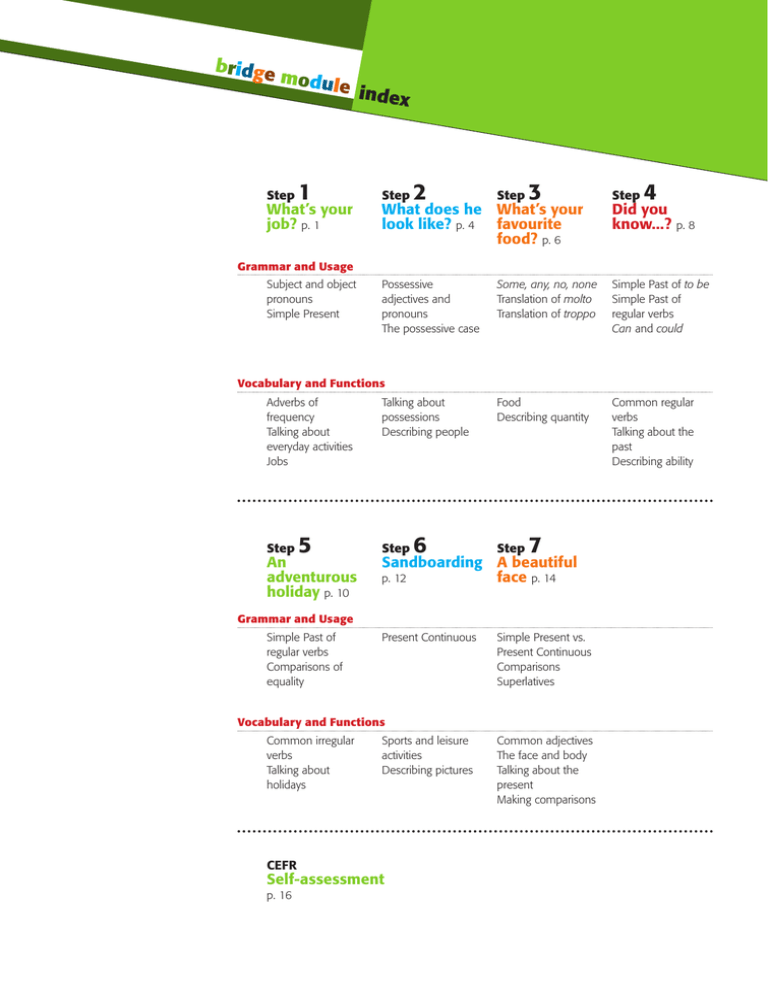
bridge
modul
Step
e ind
ex
1
What’s your
job? p. 1
A
Step
2
Step
3
What does he What’s your
look like? p. 4 favourite
food? p. 6
Step
4
Did you
know...? p. 8
Grammar and Usage
Subject and object
pronouns
Simple Present
Possessive
adjectives and
pronouns
The possessive case
Some, any, no, none
Translation of molto
Translation of troppo
Simple Past of to be
Simple Past of
regular verbs
Can and could
Food
Describing quantity
Common regular
verbs
Talking about the
past
Describing ability
Vocabulary and Functions
Adverbs of
frequency
Talking about
everyday activities
Jobs
Step
5
An
adventurous
holiday p. 10
Talking about
possessions
Describing people
Step
6
Step
7
Sandboarding A beautiful
face p. 14
p. 12
Grammar and Usage
Simple Past of
regular verbs
Comparisons of
equality
Present Continuous
Simple Present vs.
Present Continuous
Comparisons
Superlatives
Vocabulary and Functions
Common irregular
verbs
Talking about
holidays
CEFR
Sports and leisure
activities
Describing pictures
Self-assessment
p. 16
Common adjectives
The face and body
Talking about the
present
Making comparisons
step
1
What’s your job?
bridge module
Do you have an unusual job?
My name is Louise. I’m a driving instructor for a fire brigade. I’m married
and I have a five-year-old son. My job is unusual, but I love it. When I tell
people what I do, they are surprised because they think it is a dangerous job
for a woman. I run driving workshops in fire engines for groups of women.
I am very patient and I am never angry.
Hi, I’m Paul and I live in Bournemouth, UK. My job is
to pack wok sets for Chinese cooking. I get a box, put
in the wok, add some chopsticks and finally a recipe
book. After 1000 times, the work becomes boring, so I
start to write nice messages in the recipe book. I would
like to see the faces of some of the people who buy the
wok sets and read the message!
1. Read the two texts and decide if the
statements are TRUE (T) or FALSE (F).
Correct the false ones.
1.
2.
3.
4.
5.
6.
7.
8.
Louise is a firefighter.
She has two children.
People think her job is not safe.
She teaches groups of women drivers.
She often loses her temper.
Paul is Chinese.
He packs boxes.
He writes recipe books.
T|F
T|F
T|F
T|F
T|F
T|F
T|F
T|F
one
1
step
1
What’s your job?
nd object
subject ap
ronouns
Grammar
3. Complete the sentences with the
correct form of one of the verbs below.
Subject pronouns
Object pronouns
I
you
he / she / it
we
you
they
me
you
him / her / it
us
you
them
2. Underline the correct pronoun.
Can you help me / I with this exercise?
The child is hungry. Give he / him a sandwich.
Where is my pencil case? I can’t find him / it.
My relatives live in Australia. They / Them are from Sydney.
The bell is ringing. It / She is my sister. She / Her always
comes home at this time.
6. Can I / me introduce you to John? He / Him is my best
friend.
7. We / Us often invite they / them to dinner.
8. Please show we / us the way to the station.
9. She / Her usually spends her holiday with them / they.
watch | open | have | listen | carry | take | like | snow |
buy
1.
2.
3.
4.
5.
6.
7.
8.
9.
I take the bus to school.
My grandmother always . . . . . . . . . . . . . . . . . . . . TV in the afternoon.
It often . . . . . . . . . . . . . . . . . . . . in winter.
We . . . . . . . . . . . . . . . . . . . . tea at five o’clock.
The students . . . . . . . . . . . . . . . . . . . . to explanations carefully.
My husband . . . . . . . . . . . . . . . . . . . . the shopping bags for me.
The shops . . . . . . . . . . . . . . . . . . . . at nine o’clock.
They . . . . . . . . . . . . . . . . . . . . a newspaper on their way to work.
I . . . . . . . . . . . . . . . . . . . . spicy food.
1.
2.
3.
4.
5.
nt
Simple Prese
Grammar
Forma affermativa
3 soggetto (I, you, we, they) + infinito senza to R I go to
3
•
•
school every day.
soggetto (he, she, it) + infinito senza to + s R He gets
up at seven o’clock.
Se il verbo termina in -s, -ss, -x, -sh, -ch, -o, si
aggiunge la desinenza -es all’infinito senza to.
R She teaches English.
Se il verbo termina in -y preceduta da consonante,
si cambia -y in -i e si aggiunge la desinenza -es
all’infinito senza to. R He flies to London at weekends.
Forma negativa
3 soggetto (I, you, we, they) + don’t + infinito senza to
3
R I don’t go to school every day.
soggetto (he, she, it) + doesn’t + infinito senza to
R He doesn’t get up at seven o’clock.
Forma interrogativa
3 do + soggetto (I, you, we, they) + infinito senza to
3
Do you go to school every day?
does + soggetto (he, she, it) + infinito senza to
Does he get up at seven o’clock?
Il Simple Present si usa per esprimere azioni abituali e
per parlare di sentimenti e di quello che si pensa.
2
two
4. Write questions using the Simple Present
and the prompts below.
1. What / you / eat for breakfast? What do you eat for
breakfast?
2. How / you / come / to school?
3. What fruit / he / like?
4. Where / they / live?
5. Why / she / play tennis?
6. When / we / do our homework?
5. Rewrite the sentences in the negative
form.
1.
2.
3.
4.
5.
6.
I work in a bank. I don’t work in a bank.
You listen to classical music.
He plays the guitar.
She goes jogging in the park.
We like cheese.
They often go to the mountains at weekends.
Glossary: Adverbs of frequency
always sempre
usually di solito
often spesso
sometimes qualche volta
seldom/rarely/hardly ever raramente/quasi mai
never mai
6. Speak in pairs. How often do you do
the following? Answer using adverbs of
frequency.
1.
2.
3.
4.
5.
go to the gym
wash your hair
drink a cup of tea
fly to New York
phone your grandmother
bridge module
7. Speak in pairs. Ask and answer questions
about what these people do. Use the verbs
below and the objects on the right.
take | write | answer |
speak | give | tell |
visit | send emails |
catch | serve | drive |
use
microphone
What does
a doctor do?
He gives
medicine to
patients.
computer
homework
telephone
a
Vicky is a journalist.
b
Greg is a policeman.
customers
price
police car
c
Sally is a doctor.
d
camera
Jack is a teacher.
medicine
stethoscope
e
Megan is a shop assistant.
board
f
Janet is a secretary.
thief
three
3
step
2
What does he look like?
djectives
possessivedapronouns
an
1. Read the text and answer the questions
below.
1.
2.
3.
4.
5.
6.
7.
8.
Is Patricia English?
Who is Nick?
How old is he?
What does he look like?
What is strange about him?
What does Patricia like about him?
What is Nick’s room like?
How does he help his sister when she is sad?
Grammar
Possessive adjectives
Possessive pronouns
my
your
his / her / its
our your
their
mine
yours
his / hers
ours
yours
theirs
This is my book. This book is mine.
My Favourite Relative
2. Complete the sentences with the
My name is Patricia and I come from Texas, in the
South of the U.S.A. In this photograph you can see me
and my favourite relative, my brother Nick. There are so
many things I like about him. He is fifteen years old. He
is tall and slim. Don’t you think that he’s really cute? His
eyes are blue and he has short fair straight hair. He has
also got big feet!
1.
2.
3.
4.
5.
I like to play outside with my brother in my spare time.
We play volleyball and ride our bikes in the park. Nick’s
room is always a terrible mess. His sports magazines
are on the floor and his volleyball cups are on his desk.
Nick’s laptop is always on because he likes chatting with
his friends. When I’m sad, he tells silly jokes and helps
me to be happy again.
correct possessive adjective.
He is in . . . . . . . . . . . office.
Mrs Brown is my English teacher. This is . . . . . . . . . . . car.
My brothers are twins. . . . . . . . . . . . names are Jason and Nick.
We have a dog. It is . . . . . . . . . . . pet.
“Alice, where is . . . . . . . . . . . cousin?” “She is in . . . . . . . . . . . room.”
3. Complete the sentences with a
possessive pronoun.
1.
2.
3.
4.
These are my keys. These keys are . . . . . . . . . . . .
That is their house. That house is . . . . . . . . . . . .
These are our trainers. These trainers are . . . . . . . . . . . .
This is his passport. This passport is . . . . . . . . . . . .
4. Complete the sentences with the
correct possessive adjective or pronoun.
1.
2.
3.
4.
“Joe, is this . . . . . . . . . . . car?” “No, . . . . . . . . . . . is in my garage.”
We enjoy . . . . . . . . . . . job, but they don’t like . . . . . . . . . . . .
The children usually do . . . . . . . . . . . homework on time.
Angie says she can see . . . . . . . . . . . books on the desk. Tim,
where are . . . . . . . . . . . ?
5. “Is that . . . . . . . . . . . brother?” “Yes, and that’s . . . . . . . . . . . friend Tom.”
e case
the possessiv
3
possessore singolare + ‘s + cosa posseduta
Nick is Patricia’s brother.
possessore plurale + ‘ + cosa posseduta
My friends’ surname is Gillians.
Women’s clothes are on the ground floor.
3
Grammar
3 Con i plurali irregolari si usa la costruzione del
singolare.
Il genitivo sassone si può fare solo se il possessore è
animato (persona o animale) R the cat’s bowl but the
cover of the book.
4
four
bridge module
5. Underline the correct alternative.
7. Write the sentences using ‘s or of.
1. I spend my summer holidays at my house’s
grandparents / grandparents’ house.
2. Dave is the nurse’s husband / husband’s nurse.
3. He rides his brother’s bike / bike’s brother.
4. Here are the house’s keys / keys of the house.
5. The children’s toys / toys of the children are all over the
floor.
1.
2.
3.
4.
5.
6.
7.
8.
6. Listen [
1:1] to Kelly’s and Charles’s
description and say whose are the objects
below.
Example: Whose pen is this? It’s Charles’s pen.
This is (husband / my sister).
What is (telephone number / Sarah)?
The (colour / her skirt) is light blue.
(grandchildren / Fiona) love animals.
The (end / that film) is surprising.
The (tests / students) are full of mistakes.
The (legs / table) are broken.
My (car / uncle) is very old.
8. Listen [
1:2] to the descriptions and tick
the words you hear.
handsome
blonde
slim
attractive
good-looking
fair
plump
wavy
b
b
b
b
b
b
b
b
dark
rasta
freckles
ugly
tall
short
fat
thin
b
b
b
b
b
b
b
b
straight
curly
blue eyes
moustache
beard
nose
tanned
glasses
b
b
b
b
b
b
b
b
9. Describe the two people in the pictures.
five
5
step
3
What’s your favourite food?
1. Read the dialogue and write questions
for answers 1-5.
1.
2.
3.
4.
5.
..........................................................................................................
2. Mark the food that you like (√) and
the food you don’t like (x). Speak with a
classmate about your likes and dislikes.
?
In a café.
..........................................................................................................
?
..........................................................................................................
b
b
A coffee.
?
Just a little.
..........................................................................................................
b
?
Ham, cheese, tuna or chicken.
..........................................................................................................
b
b
?
b
She has some chocolate cake.
b
b
What’s on the menu?
Johnny: Waiter: Pamela: Waiter: Pamela: Waiter: Hello. Are you ready to order?
Yes, can I have a coffee, please?
OK. Do you want any milk in your coffee?
Just a little.
Would you like something to eat? We’ve
got some sandwiches. You can have ham,
cheese, tuna or chicken. I can get you
some fried eggs or an omelette. We’ve got
some sausages, some burgers...
Just a ham sandwich for me, thanks.
(looking at Pamela) What can I get you?
I would like some dessert. Have you got
any cakes?
We have fruit cake, chocolate cake and
apple pie with ice-cream.
I’d love some chocolate cake and a glass of
apple juice, please.
OK, thanks.
b
b
b
Johnny and Pamela are in a café looking
at the menu.
Waiter: Johnny: Waiter: Johnny: Waiter: b
b
b
b
b
o/none
some/any/n
Grammar
Gli aggettivi e pronomi indefiniti alcuni, dei, del,
qualche, un po’ di, ecc. si traducono come segue:
3 some in frasi affermative e domande di cortesia;
3
3
3
There are some apples in the basket.
Would you like some coffee?
any in frasi interrogative e negative con not;
Are there any desserts on the menu?
There is not any salt in the soup.
no (solo aggettivo) in frasi negative senza not;
There is no milk in the fridge.
none (solo pronome).
Are there any oranges in the basket? No, there are none.
3. Complete the sentences with some, any,
no or none.
1. 2. 3. 4. 5. 6. 7. 8. 9. 10.
6
six
Have we got . . . . . . . . . ice-cream?
He’d like an apricot but there are . . . . . . . . . left.
There are . . . . . . . . . sandwiches on the menu.
Can we have . . . . . . . . . biscuits, please?
There are . . . . . . . . . glasses in the cupboard.
I’m sorry, there is . . . . . . . . . fruitcake.
Can I put . . . . . . . . . sugar in your tea?
They have . . . . . . . . . very nice sausages.
There is . . . . . . . . . butter, but there isn’t . . . . . . . . . cheese.
“Do you have . . . . . . . . . tomatoes?” “Yes, there are . . . . . . . . . .”
bridge module
4. Look at the pictures and find the differences 5. Complete the sentences with the
between A and B.
correct translation of “molto”.
Example In picture A there is some water but there isn’t
any tea.
A
1.
2.
3.
4.
5.
6.
7.
8.
9.
10.
I do the shopping . . . . . . . . . early in the morning.
I am . . . . . . . . . hungry but there isn’t . . . . . . . . . to eat.
There are not . . . . . . . . . shops near my house.
Oranges are . . . . . . . . . good and have . . . . . . . . . vitamins.
“Do we have any mushrooms?” “Yes, but not . . . . . . . . . .”
He doesn’t eat . . . . . . . . . vegetables, but he eats . . . . . . . . . fruit.
He speaks . . . . . . . . . slowly so I can understand what he says.
Dad doesn’t take . . . . . . . . . sugar in his tea.
Are there . . . . . . . . . good restaurants in your town?
He eats . . . . . . . . . chocolate because he likes it . . . . . . . . . .
f “troppo”
translation o
3
B
3
3
3
Grammar
too + aggettivo/avverbio
This meat is too cold.
too much + sostantivo singolare
There is too much salt in the soup.
too much dopo il verbo
He spends too much on clothes.
too many + sostantivo plurale
There are too many customers in this shop.
6. Underline the correct alternative.
f “molto”
translation o
Grammar
Gli aggettivi e pronomi molto/a/i/e si traducono con:
3 a lot of davanti ai sostantivi singolari e plurali in
frasi affermative;
3
3
There are a lot of apples in the cake.
much davanti ai sostantivi singolari
interrogative e negative;
Do you drink much tea?
There isn’t much fruit to eat.
many davanti ai sostantivi
interrogative e negative.
in frasi
3
3
7. Write sentences about the pictures using
too (much / many).
plurali in frasi
Are there many vegetables in the garden?
I don’t eat many carrots.
L’avverbio molto si traduce con:
3 very davanti ad aggettivi e avverbi;
1. There is too much / too many oil in the salad.
2. He watches too much / too many TV and he gets too
much / too tired.
3. I can’t find my cup! There are too / too many dishes.
4. This translation is too / too many difficult for him.
5. I don’t like this cake; there is too / too much sugar in it.
This steak is very good.
My mother cooks very well.
a lot dopo i verbi in frasi positive;
He eats a lot.
much dopo i verbi in frasi interrogative
Does he eat much?
We don’t go out much.
a
b
c
d
e negative.
seven
7
step
4
Did you know...?
1. Listen [
1:3] to an extract from the radio
programme Did you know…? and complete
the table with the missing information.
2. Complete the following sentences with
the Simple Past of the verb to be.
1. J.F.K. was born in Massachusetts.
2. Her answers . . . . . . . . . . correct.
3. “Why . . . . . . . . . . (not) Mary at the party yesterday?” “Because
she . . . . . . . . . . busy.”
4. “. . . . . . . . . . you at home last night?” “No, I . . . . . . . . . . (not).”
5. Yes, they . . . . . . . . . . hungry and you . . . . . . . . . . thirsty.
6. There . . . . . . . . . . an important rock concert in Milan last night.
7. “. . . . . . . . . . the film interesting?” “No, it . . . . . . . . . . (not). It . . . . . . . . . .
boring!”
8. He . . . . . . . . . . (not) late, he . . . . . . . . . . early.
3. Ask and answer questions in pairs about
where you were at the following times.
1. yesterday at 8 pm
2. two hours ago
3. last summer
4. on Friday afternoon
5. yesterday morning
6. twenty minutes ago
of regulasr
Simple Past
verb
Name
Date of birth
Grammar
Forma affermativa
3 soggetto + forma base del verbo + ed (per tutte le
persone)
University
Political party
Wife
J.F.K. served in the US Navy.
Forma negativa
3 soggetto + did + not (didn’t) + forma base del verbo
Year of death
Place of death
Simple Past
of to be
Grammar
Forma affermativa
I was
you were
he / she / it was
we / you / they were
I did not study yesterday.
Forma interrogativa
3 did + soggetto + forma base del verbo
Did you watch TV last night?
Il Simple Past si usa per azioni compiute in un tempo
definito e concluso nel passato.
Yesterday I started to read that book.
Forma negativa
I was not
you were not
he / she / it was not
we / you / they were not
Forma interrogativa
was / wasn’t I
were / weren’t you
was / wasn’t he / she / it
were / weren’t we / you / they
3 Le forme negative was not e were not si possono
contrarre in wasn’t e weren’t.
8
eight
4. Rewrite the sentences in the Simple Past
using the subject and verb in brackets.
1. (my sister / to pass) her English test yesterday. My sister
passed her English test yesterday.
2. (Susan / not to listen to) rock music last night.
3. (Mum / to cook) a delicious dinner last night.
4. When (you / to visit) your grandmother?
5. (they / to refuse) to come to the football match last
Sunday.
6. (Jack / to work) for ITV last month.
7. What (the children / to study) yesterday afternoon?
8. (Carol / not to phone) her friend.
9. Where (David / to move) last year?
bridge module
5. There are some mistakes in this picture
of a scene from the 19th century. Ask and
answer questions, as in the example, using
the verbs below.
Did people
watch TV?
No, they
didn’t
watch TV.
be | play | listen to | watch | text | use | travel | snack on
can and could
Communication
Can si usa per
1. esprimere capacità e abilità; R They can speak
Spanish. / She can’t play the guitar.
2. fare una richiesta. R Can you tell me the way to the
station?
Could si usa per esprimere abilità
son could swim when he was five.
nel passato. R My
6. Complete the sentences with can,
can’t, could or couldn’t and one of the verbs
below. There is an extra verb.
play | hear | lend | watch | stop | go out | drive | speak
1. 2. 3. 4. 5. 6. 7. I . . . . . . . . . . . . . . . . . . . . . . . . my car because it is snowing.
. . . . . . . . . . . . you . . . . . . . . . . . . me your pen, please?
They . . . . . . . . . . . . . . . . . . . . . . . . talking, they are too excited.
She . . . . . . . . . . . . . . . . . . . . . . . . two languages: English and French.
. . . . . . . . . . . . you . . . . . . . . . . . . the piano for us?
Josh . . . . . . . . . . . . . . . . . . . . . . . . with his friends because he was busy.
“. . . . . . . . . . . . you . . . . . . . . . . . . me?” “No, there was too much noise.”
7. Underline the correct alternative.
1. He can / could run 100 metres when he was young.
2. They can / could cook shepherd’s pie.
3. You can’t / couldn’t speak so loudly because your sister
is asleep.
4. Yesterday I can / could buy the Christmas presents
because I wasn’t busy.
5. On Sundays we can / could sleep until late because we
don’t go to school.
6. When she was in England she can / could have bacon
and eggs for breakfast.
8. Listen [
1:4] to the dialogues and write
down the questions and the corresponding
answers.
Questions
Answers
1.
2.
3.
4.
5.
nine
9
step
5
An adventurous holiday
of irregulasr
t
s
a
P
le
p
im
S
verb
Grammar
3. Look at the pictures of Rob’s holiday in
South Africa. Then write the sentences from
exercise 2 in the correct order.
I verbi irregolari sono caratterizzati da un
paradigma. La prima voce traduce l’infinito, la
seconda il passato semplice, la terza il participio
passato. R to eat, ate, eaten
Forma affermativa
3 soggetto + 2a voce del paradigma (per tutte le
persone)
I ate. / He ate.
a
Forma interrogativa
3 did + soggetto + forma base del verbo
b
...........................................................
...........................................................
...........................................................
...........................................................
Did you eat?
Forma negativa
3 soggetto + did + not (didn’t) + forma base del verbo
She did not eat.
1. Write the Simple Past form of the
following verbs.
Infinitive
c
d
...........................................................
...........................................................
...........................................................
...........................................................
Simple Past
to buy
to drive
to eat
e
to fly
f
...........................................................
...........................................................
...........................................................
...........................................................
to go
to see
to sleep
to steal
g
2. Complete the sentences with the
Simple Past form of the irregular verbs from
exercise 1.
1.
2.
3.
4.
5.
6.
7.
8.
He . . . . . . . . . . . . . . . . . . . . a jeep into the jungle.
He . . . . . . . . . . . . . . . . . . . . some fruit in a street market.
He . . . . . . . . . . . . . . . . . . . . lions.
The monkeys . . . . . . . . . . . . . . . . . . . . his bananas during the night.
He . . . . . . . . . . . . . . . . . . . . passion fruit for dinner.
He . . . . . . . . . . . . . . . . . . . . in a tent.
Rob . . . . . . . . . . . . . . . . . . . . to Cape Town.
He . . . . . . . . . . . . . . . . . . . . on a safari.
10
ten
h
...........................................................
...........................................................
...........................................................
...........................................................
4. Rewrite the following sentences in the
Simple Past. Use the time indicators given.
1.
2.
3.
4.
5.
6.
7.
8.
My father gets up at seven o’clock. (yesterday morning)
My aunt doesn’t teach Maths. (when she was young)
I leave home after breakfast. (yesterday)
Does Mum buy bread? (on the way home from work)
They don’t go to Paris. (last weekend)
Do we make the beds? (this morning)
She drinks a cup of tea. (two hours ago)
Do you read the newspaper? (last night)
bridge module
5. Listen [
comparisons
1:5] to the dialogue between
Mark and Bridget about Mark’s holidays.
Tick the verbs or phrases you hear.
You told
Did you go
I went
Did you see
I saw
Did they enjoy
I didn’t visit
I wrote
Did you stay
I travelled
b
b
b
b
b
b
b
b
b
b
You had
Did you try
I ate
I drank
I didn’t like
Did you learn
They taught
I learnt
I didn’t meet
I took
b
b
b
b
b
b
b
b
b
b
3
of equality
Grammar
as + aggettivo/avverbio + as
Joan is as tall as George.
Your motorbike is as fast as mine.
3
as much + sostantivo non numerabile + as
I have as much homework as my sister.
3
as many + sostantivo plurale + as
You took as many photos as Alex.
8. Complete the sentences with the
correct comparison of equality.
1. Today it is . . . . . . . . . . . . . . . . . . . . . . . . . . . . . . . . . . . . yesterday. (cold)
2. Marta’s pictures are not . . . . . . . . . . . . . . . . . . . . . . . . . . . . . . . . . . . . mine.
(good)
3. There is . . . . . . . . . . . . . . . . . . . . . . . . . . . . . . . . . . . . along this road . . . . . . . . . . . . along
that one. (traffic)
4. That restaurant was not . . . . . . . . . . . . . . . . . . . . . . . . . . . . . . . . . . . . we expected.
(expensive)
5. Japan is . . . . . . . . . . . . . . . . . . . . . . . . . . . . . . . . . . . . India. (interesting)
6. They have . . . . . . . . . . . . . . . . . . . . . . . . . . . . . . . . . . . . . . . . . . . . . . . . their friends. (CDs)
7. He studied . . . . . . . . . . . . . . . . . . . . . . . . . . . . . . . . . . . . me for the Latin test.
(hard)
8. She finds Japanese . . . . . . . . . . . . . . . . . . . . . . . . . . . . . . . . . . . . Arabic. (difficult)
9. Look at the information about Cathy’s and
Julian’s typical day. Complete the sentences
with comparisons of equality.
Cathy
Julian
School subjects maths, science,
English, PE,
French
6. Listen [
1:5] again and fill in the table
with the missing information.
Where did Mark go?
When did he go?
How long did he stay?
What food did he eat?
What did he drink?
Latin, maths,
history, English,
French, German
Hours of study
per day
8
8
Foreign
languages
French
French, German
Sports
swimming,
tennis
none
Time in front
of TV
2 hours
3 hours
Did he speak the language?
How many photos did he take?
7. Speak in pairs. Practise questions and
answers using the information from exercise 6.
1. 2. 3. 4. 5. Cathy hasn’t got . . . . . . . . . . . . . . . . . . . . . . . . . . . . . . . . . . . . . . . . . . . . . . . . . . . . . . . . . . . . . . . . . . . . . . . . . . . . . . .
Cathy studies . . . . . . . . . . . . . . . . . . . . . . . . . . . . . . . . . . . . . . . . . . . . . . . . . . . . . . . . . . . . . . . . . . . . . . . . . . . . . . . . . . . . .
She doesn’t speak . . . . . . . . . . . . . . . . . . . . . . . . . . . . . . . . . . . . . . . . . . . . . . . . . . . . . . . . . . . . . . . . . . . . . . . . . .
Julian doesn’t play . . . . . . . . . . . . . . . . . . . . . . . . . . . . . . . . . . . . . . . . . . . . . . . . . . . . . . . . . . . . . . . . . . . . . . . . . .
Cathy doesn’t spend . . . . . . . . . . . . . . . . . . . . . . . . . . . . . . . . . . . . . . . . . . . . . . . . . . . . . . . . . . . . . . . . . . . . . .
eleven
11
.
.
.
.
.
step
6
Sandboarding
1. Read the text and answer the questions
below.
1.
2.
3.
4.
2. Look at the shadows and write sentences
using the Present Continuous.
How does sandboarding differ from snowboarding?
What is Andy doing in the picture?
What is he wearing?
Why is he wearing light clothes?
to play basketball | to sail | to jog | to ski | to play golf |
to swim | to play tennis | to ride a horse
Sandboarding
Sandboarding is similar to snowboarding, but it takes
place on sand dunes. Andy, the boy in the picture,
is riding down a dune and is standing with both feet
strapped to a board. Participants in this sport walk or
drive back to the top of the dune after every “run” or
“ride”. When you go sandboarding you need special
equipment. Andy is wearing kneepads, special gloves
and boots. He is surfing on a hard base and is wearing
light clothes because it is very hot in the desert.
a
He . . . . . . . . . . . . . . . . . . . . . . . . . . . . . . . . . . . . . . . . . . . . . . . . . . . . .
......................................................... .
c
They . . . . . . . . . . . . . . . . . . . . . . . . . . . . . . . . . . . . . . . . . . . . . . . . .
......................................................... .
nuous
Present Conti
She . . . . . . . . . . . . . . . . . . . . . . . . . . . . . . . . . . . . . . . . . . . . . . . . . . .
......................................................... .
d
He . . . . . . . . . . . . . . . . . . . . . . . . . . . . . . . . . . . . . . . . . . . . . . . . . . . . .
.
.........................................................
Grammar
Forma affermativa
3 soggetto + presente del verbo essere + gerundio del
b
verbo principale
I am surfing.
He / She is surfing.
e
She . . . . . . . . . . . . . . . . . . . . . . . . . . . . . . . . . . . . . . . . . . . . . . . . . . .
......................................................... .
f
He . . . . . . . . . . . . . . . . . . . . . . . . . . . . . . . . . . . . . . . . . . . . . . . . . . . . .
......................................................... .
Forma interrogativa
3 presente del verbo essere + soggetto + gerundio del
verbo principale
Are you surfing?
Is he/she surfing?
Forma negativa
3 soggetto + presente del verbo essere + not + gerundio
del verbo principale
I am not surfing.
He / She is not (isn’t) surfing.
12
twelve
g
She . . . . . . . . . . . . . . . . . . . . . . . . . . . . . . . . . . . . . . . . . . . . . . . . . . .
......................................................... .
h
They . . . . . . . . . . . . . . . . . . . . . . . . . . . . . . . . . . . . . . . . . . . . . . . . .
.
.........................................................
bridge module
3. Write questions and answers to describe
the pictures. Use the prompts below.
Example Is Kitty having a shower? No, she isn’t. She is
reading a book.
4. Find the differences between picture A
and picture B. Write down ten sentences.
1. In picture A the girl is walking up the stairs.
2. . . . . . . . . . . . . . . . . . . . . . . . . . . . . . . . . . . . . . . . . . . . . . . . . . . . . . . . . . . . . . . . . . . . . . . . . . . . . . . . . . . . . . . . . . . . . . . . . . . . . . . . . . . . . . . . . .
3. . . . . . . . . . . . . . . . . . . . . . . . . . . . . . . . . . . . . . . . . . . . . . . . . . . . . . . . . . . . . . . . . . . . . . . . . . . . . . . . . . . . . . . . . . . . . . . . . . . . . . . . . . . . . . . . . .
4. . . . . . . . . . . . . . . . . . . . . . . . . . . . . . . . . . . . . . . . . . . . . . . . . . . . . . . . . . . . . . . . . . . . . . . . . . . . . . . . . . . . . . . . . . . . . . . . . . . . . . . . . . . . . . . . . .
5. . . . . . . . . . . . . . . . . . . . . . . . . . . . . . . . . . . . . . . . . . . . . . . . . . . . . . . . . . . . . . . . . . . . . . . . . . . . . . . . . . . . . . . . . . . . . . . . . . . . . . . . . . . . . . . . . .
6. . . . . . . . . . . . . . . . . . . . . . . . . . . . . . . . . . . . . . . . . . . . . . . . . . . . . . . . . . . . . . . . . . . . . . . . . . . . . . . . . . . . . . . . . . . . . . . . . . . . . . . . . . . . . . . . . .
7. . . . . . . . . . . . . . . . . . . . . . . . . . . . . . . . . . . . . . . . . . . . . . . . . . . . . . . . . . . . . . . . . . . . . . . . . . . . . . . . . . . . . . . . . . . . . . . . . . . . . . . . . . . . . . . . . .
8. . . . . . . . . . . . . . . . . . . . . . . . . . . . . . . . . . . . . . . . . . . . . . . . . . . . . . . . . . . . . . . . . . . . . . . . . . . . . . . . . . . . . . . . . . . . . . . . . . . . . . . . . . . . . . . . . .
9. . . . . . . . . . . . . . . . . . . . . . . . . . . . . . . . . . . . . . . . . . . . . . . . . . . . . . . . . . . . . . . . . . . . . . . . . . . . . . . . . . . . . . . . . . . . . . . . . . . . . . . . . . . . . . . . . .
10. . . . . . . . . . . . . . . . . . . . . . . . . . . . . . . . . . . . . . . . . . . . . . . . . . . . . . . . . . . . . . . . . . . . . . . . . . . . . . . . . . . . . . . . . . . . . . . . . . . . . . . . . . . . . . . . . .
A
a
have a shower / Kitty / read
a book
c
ride in the park / my
brother / lie on the sofa
e
have breakfast / Derek / get
dressed
b
listen to the radio / Mum /
make a cake
d
B
ski / Susan and Terry / skate
f
play volleyball / Dave, Bob
and Mick / watch TV
thirteen
13
.
.
.
.
.
.
.
.
.
step
7
A beautiful face
s. Presenst
v
t
n
e
s
re
P
le
Simp
Continuou
comparisons
Grammar
Grammar
Il Simple Present si usa per esprimere abitudini o
routine. E’ spesso accompagnato dagli avverbi di
frequenza. R I always brush my teeth after lunch.
3
Il Present Continuous si usa per descrivere un’azione in
corso di svolgimento. R I’m brushing my teeth now.
3 Gli aggettivi e gli avverbi monosillabici e gli
aggettivi bisillabici terminanti in -y, -le, -er,
-ow formano il comparativo di maggioranza
aggiungendo la desinenza -er.
3
Il Present Continuous non si può usare con i verbi di:
• stato; R to be, to cost
• percezione involontaria; R to see, to hear, to smell, to
slim R slimmer
• Gli aggettivi bisillabici terminanti in consonante
+ -y trasformano la -y in -i e aggiungono -er.
1. Tick the correct sentence.
2. Complete the sentences with the
correct form of the verb in brackets.
1. They . . . . . . . . . . . . . . . . . . . . . (to live) in York, but they . . . . . . . . . . . . . . . . . . . . . (to
work) in London at the moment.
2. “What . . . . . . . . . . . . . . . . . . . . . (your father / to do)?” “He . . . . . . . . . . . . . . . . . . . . .
(to be) an architect. He . . . . . . . . . . . . . . . . . . . . . (to design) a new
house at the moment.”
3. Can you lend me your book or . . . . . . . . . . . . . . . . . . . . . (you / to
read) it?
4. Look! It . . . . . . . . . . . . . . . . . . . . . (to snow).
5. “. . . . . . . . . . . . . . . . . . . . . (you / to remember) Mr Folin?” “Yes, he
. . . . . . . . . . . . . . . . . . . . . (to teach) French in Susan’s class.”
6. The children usually . . . . . . . . . . . . . . . . . . . . . (to play) with their toys
in their bedroom.
7. She never . . . . . . . . . . . . . . . . . . . . . (to wash) her hair in the morning.
She . . . . . . . . . . . . . . . . . . . . . (to prefer) to have a shower in the
evening.
8. “Where . . . . . . . . . . . . . . . . . . . . . (they / to come) from?” “They
. . . . . . . . . . . . . . . . . . . . . (to come) from Edinburgh, but they
. . . . . . . . . . . . . . . . . . . . . (to stay) with their relatives in Brighton now.”
14
fourteen
nice R nicer
• Gli aggettivi monosillabici terminanti in
consonante preceduta da una sola vocale
raddoppiano la consonante.
believe
a. She always washes the dishes.
b. She always is washing the dishes.
a. How much does that dress cost?
b. How much is that dress costing?
a. Do you like that ice-cream?
b. Are you liking that ice-cream?
a. The students do the test now.
b. The students are doing the test now.
a. Hurry up! The bus is coming.
b. Hurry up! The bus comes.
a. Do you know him?
b. Are you knowing him?
short R shorter
Spelling rules
• Gli aggettivi monosillabici terminanti in -e muta
perdono la -e e aggiungono -er.
taste
• sentimento; R to like, to want, to need
• possesso; R to have, to belong
• attività della mente. R to know, to understand, to
1.
2.
3.
4.
5.
6.
more + aggettivo di due o più sillabe + than
His face is more attractive than I thought.
more + avverbio terminante in -ly + than
You speak more clearly than your friend.
easy R easier
3. Look at the pictures and write comparisons.
a
man / his wife (thin)
The man is thinner than his
wife.
b
cheetah / horse (fast)
...........................................................
...........................................................
c
black shoes / red shoes
(expensive)
...........................................................
...........................................................
bridge module
4. Complete the sentences with the
superlative form of the adjective in brackets.
atlantic
ocean
pacific ocean
pacific ocean
atlantic
ocean
d
Pacific Ocean / Atlantic
Ocean (big)
...........................................................
1.
2.
3.
4.
He is watching . . . . . . . . . . . . . . . . . . . . . programme on TV. (boring)
Mrs Brown is . . . . . . . . . . . . . . . . . . . . . teacher of the school. (strict)
I am . . . . . . . . . . . . . . . . . . . . . of my brothers. (tall)
My niece has a dog. It is . . . . . . . . . . . . . . . . . . . . . pet that I know.
(lovely)
5. The Nile is . . . . . . . . . . . . . . . . . . . . . river in the world. (long)
6. Alice is . . . . . . . . . . . . . . . . . . . . . of my colleagues. (friendly)
7. This is . . . . . . . . . . . . . . . . . . . . . holiday of our lives. (exciting)
8. Chinese is . . . . . . . . . . . . . . . . . . . . . language in the world. (difficult)
5. Listen [
1:6] to Nick describing his
cousins, Carol and Brian. As you listen, label
the parts of the face and the body that you
hear.
...........................................................
a.
e
Tom / Nick (sad)
...........................................................
b.
...........................................................
e.
d.
c.
f.
f
Mt. Everest / Mont Blanc
(high)
...........................................................
g.
i.
h.
...........................................................
superlatives
j.
Grammar
most + aggettivi di due o più
the +
sillabe e avverbi terminanti in -ly
aggettivi e avverbi monosillabi e
bisillabi in -y, -le, -er, -ow + -est
Il secondo termine di paragone è introdotto da:
3 of + specificazione; R Mark is the cleverest student
of his class.
3 in + specificazione di luogo; R New York is the
most expensive city in the world.
3 that + frase relativa. R He is the funniest person
(that) I know.
6. Listen [
1:6] again and complete the
sentences with the missing information.
1.
2.
3.
4.
5.
6.
7.
8.
My cousin Carol is very . . . . . . . . . . . . . . . . . . . . . . .
She has the . . . . . . . . . . . . . . . . . . . . . . face of her friends.
Her hair is . . . . . . . . . . . . . . . . . . . . . . than mine and . . . . . . . . . . . . . . . . . . . . . . .
Her skin is the . . . . . . . . . . . . . . . . . . . . . . of her family.
Her nose is . . . . . . . . . . . . . . . . . . . . . . than her sister’s.
My cousin Brian is . . . . . . . . . . . . . . . . . . . . . . than me.
His legs are . . . . . . . . . . . . . . . . . . . . . . than mine.
He has the . . . . . . . . . . . . . . . . . . . . . . arms and the . . . . . . . . . . . . . . . . . . . . . . feet of
all the cousins.
9. Is that the reason why he has . . . . . . . . . . . . . . . . . . . . . . ears?
fifteen
15
Self-assessment
The descriptors on this page are based on CEFR
(Common European Framework of Reference).
Think about the level you have reached in every
ability and tick the correct column. Then discuss
your results with your teacher.
I can
do it!
I can do it
confiden
tly!
Listening
A2
A2
A2
B1
B1
B1
B1
Reading
B1
B1
B1
I can understand words and phrases related to basic
personal information (job, family, possessions).
I can understand the main idea in a short simple text.
I can understand basic information about people.
I can understand everyday language conversation about
food, jobs, holidays, etc.
I can understand the main points of a radio programme
on a topic of interest.
I can identify specific information in simple speech.
I can understand people talking about past experiences.
I can’t
do it!
xxx
xx
x
I can understand key points in a text on a topic of interest.
I can skim and scan an article for specific information
about everyday topics.
I can guess the meaning of an unknown word from the
context.
Spoken interaction
A2
A2
A2
B1
Spoken production
I can ask what people and things are like and react.
I can talk about my daily routine.
I can discuss pictures about familiar topics.
I can maintain a collaborative task on an everyday topic.
A2
A2
A2
I can describe myself and other people.
I can describe pictures of everyday activities.
I can speak about the differences between two photos
and the past and the present.
I can give a short account of my experiences.
I can use memorised words and phrases to speak about
my daily routine, eating habits and leisure activities.
I can use simple grammar structures.
I can express past and current experiences.
I can write simple sentences.
I can draw comparisons.
I can write simple questions and answers.
B1
Use of language
A2
A2
B1
Writing
A2
A2
A2
16
sixteen

